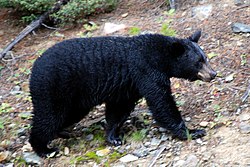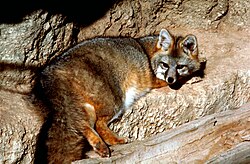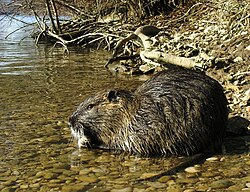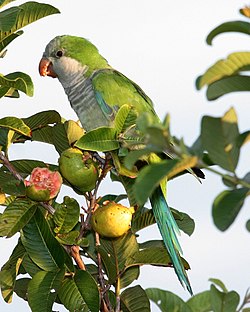What Animals Can You Hunt In Louisiana

The creature of Louisiana is characterized by the region'south low swamplands, bayous, creeks, woodlands, coastal marshlands and beaches, and barrier islands covering an estimated 20,000 square miles (52,000 square kilometers), corresponding to 40 percent of Louisiana's total land area. Southern Louisiana contains up to 50 percent of the wetlands establish in the Continental United States, and are made upward of countless bayous and creeks.
The Creole Country has a humid subtropical climate, perhaps the all-time example of a humid subtropical climate of all the Southern United States with long, boiling and hot summers and short, mild winters. The subtropical characteristics of the state are due in large role to the influence of the Gulf of Mexico, which at its uttermost betoken is no more than than 200 miles (320 kilometers) away. Louisiana'due south varied habitats — tidal marshes, bayous, swamps, woodlands, islands, forests, and prairies — offer a variety of wild fauna.
Some of the virtually common animals found throughout all of the parishes include otter, deer, mink, muskrat, raccoons, opossums, rabbits, squirrels, nutria, turtles, alligators, woodcocks, skunks, foxes, beavers, ringtails, armadillos, coyotes and bobcats. Deer, squirrel, rabbit, and bear are hunted as game, while muskrat, snakes, nutria, mink, opossum, bobcat, and skunk are commercially significant for fur. Prized game birds include quail, turkey, woodcock, and various waterfowl, of which the mottled duck and wood duck are native. There are several endemic plants and animals in Louisiana that are institute nowhere else on Earth; an example could be the Louisiana bluestar or the white leucistic alligator.[ii] The Pearl River map turtle and the ringed map turtle are only found in Louisiana and neighboring State of Mississippi.
Louisiana contains a number of areas which are, in varying degrees, protected from human intervention. In addition to National Park Service sites and areas and the Kisatchie National Forest, Louisiana operates a organisation of state parks, state historic sites, one country preservation expanse, one land forest, and many Wildlife Management Areas. The Nature Conservancy too owns and manages a set of natural areas.
State ecology [edit]

Much of the state's lands were formed from sediment washed downward the Mississippi River, leaving enormous deltas and vast areas of littoral marsh and swamp. The northern parts of Louisiana mostly consist of woodlands which are home to deer, squirrels, rabbits, bears, muskrats, mink, opossums, bobcats, and skunks. Louisiana's forests offer a mix of oak, pine, beech, black walnut, and cypress trees. In the Piney Woods in the Ark-La-Tex-region, mammals such every bit the N American cougar, gray play a trick on, feral hogs (razorback), and snakes such as the western cottonmouth, the western worm snake, the Louisiana pine ophidian, besides as other animals are common.[4]
Louisiana's largest forest, the Kisatchie National Forest in the forested hills of Central Louisiana, has 155 species of breeding birds, 48 mammal species, 56 reptile species and 30 amphibian species. It is some 600,000 acres (240,000 hectares) in expanse, more than than half of which is vital flatwoods vegetation, which supports many rare plant and animal species. These include for case the Louisiana pino snake, the red-cockaded woodpecker, the Louisiana blackness bear and the Louisiana pearlshell.[5]
Alligators are common in Louisiana'southward all-encompassing swamps, bogs, creeks, lakes, rivers, wetlands, and bayous. Other water-loving reptiles such equally the alligator snapping turtle live in the Louisiana swamps. The alligator snapping turtle is characterized by a very large head and 3 rows of spiked scutes. These wetlands of Louisiana make ideal homes for several species of turtles, crawfish and catfish - all of which are popular Acadian foods.
Jambalaya, a Louisiana Creole dish that originated amid the Cajuns in Acadiana, is made entirely by all sorts of meat found in the swampland of southern Louisiana: crawfish, herons, shellfish, catfish, toads, frogs, shrimp, oysters, alligator, duck, turtle, boar, venison, and myriad other species. Among invasive species that thrive in the wetlands of Louisiana is the nutria, a Due south American rodent that was likely introduced when private animals escaped from fur farms.
Mammals [edit]

The Louisiana black behave was designated the Official Land Animal in 1992.[six]
Forty species of mammals reside in Louisiana,[7] excluding marine mammals. Seventy mammal species have been recorded in Louisiana or its firsthand adjacent waters.[viii] Louisiana has, for example, two species of squirrels: gray squirrels and play a trick on squirrels, co-ordinate to the Louisiana Department of Wildlife and Fisheries.[9]
Louisiana has two species of rabbits: eastern cottontails and swamp rabbits. Although the cottontail is considered more of an upland species and the swamp rabbit a wetland species, both species occur throughout the country. Rabbits have loftier productive rates in Louisiana when habitat and weather conditions are adept.
Louisiana blackness bear [edit]

The Louisiana blackness deport (Ursus americanus luteolus) is one of xvi currently recognized subspecies of American blackness behave.[10]
The Louisiana black acquit in one case ranged throughout the State of Louisiana and parts of adjacent neighboring Mississippi, Arkansas, and Texas. The black bear was common at the time of early colonization, serving as food for Native Americans for generations.
An 1890 record shows 17 parishes containing bears, all of them by the Mississippi-edge and the Atchafalaya region. Information technology was reported that the most all-encompassing areas of bottomland hardwoods in the state have "at least a few bears", with the greatest number found in the denser woodlands along the Tensas, Crimson, Black, and Atchafalaya Rivers. In the late 1950s, bears occupied habitat in the Tensas-Madison surface area in northeast Louisiana and in the lower fringes of the Atchafalaya Basin.
Today, blackness bears can exist found in all of Louisiana, but according to the Louisiana Department of Wildlife and Fisheries, nearly black bears are observed in a confined region made up of the post-obit parishes: W- and Due east Carroll, Richland, Franklin, Madison, Tensas, Catahoula, Concordia, Avoyelles, Pointe Coupee, St. Landry, Vermilion, Iberia, as well as both St. Martin and St. Mary.[11]
Blackness deport could exist legally hunted in parts of Louisiana through the late 1980s. 1 of the last organized bear hunts in Louisiana occurred December 15, 1955. During this hunt, five bears were harvested in the Lake Providence area. Information technology was recommended to the Wildlife Commission that the conduct flavour be closed. Conduct hunting was closed the post-obit flavour and remained closed until 1961. The flavour was opened again from 1962 to 1965 with hunting permitted only in northeast Louisiana and in the coastal parishes. The hunting season was again closed from 1966 to 1974. Information technology was reopened in 1975–1987 with hunting restricted to the Atchafalaya Basin.[12]
The Louisiana bear hunting season has remained closed since 1988. From 1964 through 1967, 161 black bears were live-trapped in Cook County, Minnesota and released in the Mississippi and Atchafalaya River bottoms of Louisiana in an endeavour to restock black behave to the land. Past 1968 there was evidence that the translocated bears were reproducing. However, nigh of the relocated bears were killed on roads, as nuisance animals, or during recapture.[12]
Every bit of 2016, Louisiana blackness bears are no longer endangered.[13]
Reptiles [edit]

Wild leucistic alligators are only constitute in Louisiana.[14]
The American alligator is the official country reptile of Louisiana. Mayhap the nearly iconic of Louisiana wetlands' animals, the American alligator has bounced dorsum from virtually extinction to being relatively commonplace. An abundance of snake species make their home in Louisiana, including the eastern diamondback rattlesnake, Texas coral snake, eastern yellowbelly racer, mud snake, western pigmy rattlesnake, northern scarlet snake, rainbow ophidian, buttermilk racer, tan racer, northern cottonmouth, red cornsnake, pit vipers and kingsnake.[15]
America's largest freshwater turtle, the alligator snapping turtle, shares the habitat with its cousin, the common snapping turtle. The green American chameleon too lives in the wetlands, along with the cadger-like tiger salamander, which is an amphibian. Other examples of reptiles in Louisiana are the gopher tortoise, razor-backed musk turtle, broad-headed skink, coal skink and the slender glass lizard.
According to the Louisiana Alligator Council, at that place are over one meg alligators in the land in 2014 and the number is continuously increasing.[16] Alligators like swamps, rivers, lakes or wherever they can have an adequate habitat. Louisiana has several varieties of venomous snakes. The eastern coral ophidian, Texas coral snake, eastern copperhead, cottonmouth, western pygmy rattlesnake, and the eastern diamondback rattlesnake and canebrake rattlesnake can all be found in Louisiana.
The largest reported American alligator was a male person killed in 1890 on Marsh Island in Louisiana, and reportedly measured at 19 feet (5.8 meters).[17]
Birds [edit]

Approximately 160 species of birds are twelvemonth-circular residents or probable confirmed breeders in Louisiana and another 244 are known to regularly migrate through or winter in the state or its firsthand adjacent waters.[eight] There are 69 species on the CWCS species of conservation concern listing of which 42 species are considered critically threatened, imperiled or rare, co-ordinate to the Louisiana Natural Heritage Program. Shorebirds and songbirds constitute the majority of species. In 1902, the eastern brown pelican was made a part of the Seal of Louisiana and, ten years later, in 1912, the pelican and her young adorned the flag of Louisiana as well. The official nickname of Louisiana is the Pelican State.
In 1958, the pelican was made the official land bird of Louisiana. This human activity was amended on July 26, 1966, to specifically designate the brownish pelican, the National Basketball Association'due south New Orleans Pelicans are named in honour of Louisiana'southward state bird. The eastern dark-brown pelican is also the national bird of Barbados and the Turks and Caicos Islands, it is also ane of the mascots of Tulane University and is on the seals of Tulane University, Louisiana Country Academy and the University of Louisiana at Lafayette.
Shore birds are arable in Louisiana and the most common is the nifty white egret. This big, all-white heron has an impressive wingspan and stature. The egret occurs often in the wetlands of Louisiana and littoral areas that provides it with plenty of fish, amphibians and minor mammals to banquet on. This bird is also the official symbol of the National Audubon Society.
The American bald eagle nests in southeastern coastal parishes and, occasionally on large lakes in northern and fundamental parishes, but these nests are less successful. Some of America'south tallest birds, such as the smashing blue heron and great egret, cannot resist the line-fishing opportunities that be in the Louisiana swampland. Raptors such as the osprey, American black vulture and barred owl live in the marshes of southern Louisiana. Migratory waterfowl and songbirds oftentimes make stopovers or actually spend the winter in these wetlands.
Amphibians [edit]

The American greenish tree frog was designated the official state amphibian of Louisiana in 1993.[eighteen] Examples of other amphibians in Louisiana are salamanders such as the eastern tiger salamander, southern cherry-red-backed salamander, Gulf Declension waterdog, dwarf salamander and the three-toed amphiuma. There are also toads such every bit Hurter'due south spadefoot toad and southern toad, equally well as frogs such equally pig frog, striped chorus frog and the bronze frog. American bullfrogs are the largest frogs native to Louisiana.
Fish [edit]
The white perch, sometimes called sac au lait from Cajun French, was designated the official country fish of Louisiana in 1993.[nineteen] Coastal beaches are inhabited past ocean turtles. Freshwater fish include bass, crappie, and bream. Ruddy and white crawfishes are the leading commercial crustaceans.
Many sharks accept been observed in Louisiana waters; including, but not limited to lemon sharks, tiger sharks, bull sharks and blacktip sharks. The sharks, for case the balderdash shark, have often been observed throughout the Atchafalaya Basin, 900 miles upwards the Mississippi River, and in inland bayous and wetlands.[20] The alligator gar and the frecklebelly madtom, which is native to Pearl River in Southeastern Louisiana, are two additional species of fish in Louisiana.
The bowfin, known by many other names such as the mudfish, dogfish, grinnel, grindel, jack, jackfish, cypress trout, cotton fiber fish, and in Southward Louisiana; choupique (pronounced shoe-pick or shoe-peg),[21] [22] or chew-pic,[23] is found in many areas of Louisiana.
Endangered species [edit]

The gray fox lives throughout Louisiana, but is still threatened.[24] They are most mutual in forested northern areas.
Threatened animal species include five species of ocean turtles: green, hawksbill, Kemp'south ridley, leatherback, and loggerhead. Twenty-iii Louisiana animal species were on the U.S. Fish and Wildlife Service's threatened and endangered species list for 2003. Among those listed are the Louisiana blackness acquit, American bald eagle, inflated heelsplitter, and red-cockaded woodpecker. The Louisiana WAP identifies 240 species of business concern. The mount lion population in Louisiana is small but growing in recent times. There is a relatively small and threatened population of Louisiana black bears.
The historic range of the Florida panther extended from Florida to Louisiana throughout the Gulf Coast states and Arkansas. Today, the only place with wild Florida panthers is the southwestern tip of Florida. The Florida panther is considered of historical occurrence in Louisiana. The historic range included as far west as Western Louisiana and the East Lower Mississippi River Valley through the southeastern states. Even though numerous sighting reports continue to surface annually throughout its historic range, it is unlikely that viable populations of the Florida panther presently occur exterior of the State of Florida. The Louisiana blackness bear has been taken off the endangered species listing. Mississippi diamondback terrapin is recognized as a "species of concern" in Louisiana, but is institute on the Mississippi border.
Invasive species [edit]

The nutria, likewise known equally coypu [25] or river rat,[26] is an invasive species. Its destructive feeding and burrowing behaviors make this invasive rodent a pest throughout Louisiana.

Nutria [edit]
Tabasco tycoon and naturalist Edward McIlhenny brought thirteen adult nutria from Argentine republic to his domicile in New Iberia, during the 1930s, for the fur farming industry.[27] Two years later, one hundred and fifty got out of the pen, supposedly escaping during a storm. The nutria reproduced at a high rate, increasing by the thousands every year. By the 1960s the number ranged to every bit high as twenty million, and increasing. Past the time the government instituted a control program, the nutria was destroying Louisiana marshes and wetlands, causing widespread erosion. In the 21st century, the nutria is 1 of the virtually common and despised pests in the Bayou Country.[28]
The story of the nutria is not unique. Many species of birds, mammals, fish, and plants have been introduced into the Louisiana surroundings in the by two centuries. Exotic species, or species that have been introduced to areas exterior their native range, take heavy tolls on the ecosystems they colonize. Some invaders, such as the leafy vine kudzu (Pueria lobelia), destroy the habitat for resident wildlife. Other species fiercely compete with native plants and animals for resources.
By some estimates, exotic species pose the 2nd most serious threat to endangered species later on habitat loss. Nutria were introduced into littoral marshes from Latin America in the mid-1900s, and their population has since exploded into the millions. They cause serious damage to coastal marshes and may dig burrows in levees. Hence, Louisiana has had a bounty to endeavour to reduce nutria numbers.
Large alligators feed heavily on nutria, then alligators may non only control nutria populations in Louisiana, only also prevent them spreading east into Florida and possibly the Everglades. Since hunting and trapping preferentially accept the big alligators that are the most important in eating nutria, some changes in harvesting may be needed to capitalize on their ability to control nutria.
Monk parakeet [edit]
An agricultural pest in its native South American range, the monk parakeet was first brought to the U.S. as a muzzle bird. They were so popular that over threescore,000 were imported between 1969 and 1972. By the 1980s it had already been released in many parts of the country and had established small breeding colonies. 20 years subsequently, monk parakeet numbers have increased exponentially just their distribution remains spotty.
Monk parakeets tend to be restricted to urban areas where they feed and nest in ornamental palm copse, occupying a niche that no indigenous bird holds. So far, their distribution in Louisiana has been express almost exclusively to the City of New Orleans, where they have had no adverse furnishings on local wild animals. If their numbers increase, however, monk parakeets could pose a serious threat to agricultural areas, possibly becoming every bit much of a pest hither as they already are in their native range.
Red fire ant [edit]
Native to South America, the red burn ant has flourished in many southern U.S. states since its introduction in the 1930s. Superficially similar to well-nigh other ants, the burn ant is a vicious predator, attacking birds, rodents, and larger mammals in swarms.
I study of white-tailed deer found that death rates for young deer were twice as loftier in areas with fire ants as in uninfested areas. In Louisiana, the spread of fire ants has been linked to the decline of the loggerhead shrike and some species of warblers. The red burn ant has replaced nearly one-half the native insect species in some areas it has colonized.
See also [edit]
- Creature of the United States
References [edit]
- ^ "Archived copy". Archived from the original on 2014-03-05. Retrieved 2014-03-01 .
{{cite web}}: CS1 maint: archived copy as title (link) - ^ "Audubon Nature Institute - Jubilant the Wonders of Nature - New Orleans". audubonnatureinstitute.org . Retrieved 2021-08-21 .
- ^ "Coastal Louisiana Basins". lacoast.gov . Retrieved 2021-08-21 .
- ^ Feral hogs
- ^ United states of america Section of Agriculture. 1999. Final Ecology Impact Argument. Revised Land and Resource Management Programme. Kisatchie National Forest. Wood Service, Southern Region, Pineville, LA.
- ^ "Louisiana Black Acquit | Land Symbols USA". statesymbolsusa.org . Retrieved 2021-08-21 .
- ^ Richey, Emma Cecilia; Kean, Evelina Prescott (1915). The New Orleans Book. L. Graham Company, Limited, Printers. p. 95.
louisiana has species of mammals.
- ^ a b Taxonomic groups
- ^ "Quail, Rabbit, and Squirrel -Hunting, Research, and Management | Louisiana Section of Wildlife and Fisheries". world wide web.wlf.louisiana.gov . Retrieved 2021-08-21 .
- ^ "Louisiana Black Bear" (PDF). tpwd.texas.gov . Retrieved 21 August 2021.
- ^ Bear snare
- ^ a b Behave conservation Kickoff
- ^ Wold, Amy. "Written report: Iconic Louisiana blackness comport 'Teddy comport' to exist removed from Endangered Species list". The Advocate . Retrieved 2021-08-21 .
- ^ "White alligator is ane of rarest in world - Telegraph". 2009-02-18. Archived from the original on 2009-02-18. Retrieved 2021-08-21 .
- ^ Evans, Beau (June 12, 2017). "Snakes of Louisiana: 46 of the state's slithery species". The Times-Picayune. New Orleans, LA. NOLA.com. Archived from the original on 13 June 2017.
- ^ "Archived copy". Archived from the original on 2014-07-20. Retrieved 2014-03-01 .
{{cite spider web}}: CS1 maint: archived copy as title (link) - ^ Wood, Gerald (1983). The Guinness Book of Beast Facts and Feats. ISBN 978-0-85112-235-9
- ^ "Louisiana State Amphibian | Green Tree Frog". statesymbolsusa.org . Retrieved 2021-08-21 .
- ^ "White Perch Country Freshwater Fish | State Symbols U.s.a.". statesymbolsusa.org . Retrieved 2021-08-21 .
- ^ "Bull sharks take to Louisiana swamp". www.wafb.com . Retrieved 2021-08-21 .
- ^ choupique= shoe pick or shoe-peg: How We Talk: American Regional English Today (past Allan A. Metcalf: Houghton Mifflin Harcourt, 2000), pp 34- Retrieved 2017-08-08
- ^ Louisiana Sportsman: choupique= shoe-pick Archived 2017-08-09 at the Wayback Car (February 2, 2009)- Retrieved 2017-08-08
- ^ Google pronunciation of choupique= chew-pic- Retrieved 2017-08-08
- ^ "Urocyon cinereoargenteus". www.fs.fed.us . Retrieved 2021-08-21 .
- ^ http://oldredlist.iucnredlist.org/details/14085/0 [ permanent dead link ] [ expressionless link ]
- ^ Martin, Horace Tassie (1892). Castorologia: Or the History and Traditions of the Canadian Beaver. W. Drysdale.
- ^ Nutria nutria.com Retrieved 2017-03-29
- ^ Tulane: The Louisiana Environment: Nutria, Exotic Species in Louisiana- Retrieved 2017-03-29
Source: https://en.wikipedia.org/wiki/Fauna_of_Louisiana
Posted by: sorensontreas1988.blogspot.com

0 Response to "What Animals Can You Hunt In Louisiana"
Post a Comment